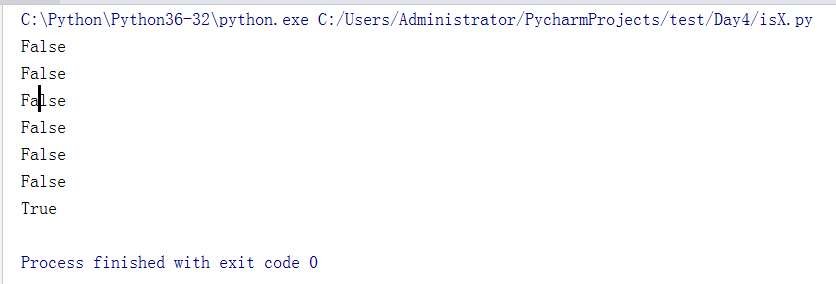随笔记录方便自己和同路人查阅。
#------------------------------------------------我是可耻的分割线-------------------------------------------
除了islower()和isupper()方法外,还有几个isX的字符串方法,这些方法返回一个布尔值,描述了字符串
的特点。
isalpha()返回True,如果字符串只包含字母,并且非空
isalnum()返回True,如果字符串只包含字母和数字,并且非空
isdecimal()返回True,如果字符串只包含数字字符,并且非空
isspace()返回True,如果字符串只包含空格、制表符和换行,并且非空
istitle()返回True,如果字符串仅包含以大写字母开头、后面都是小写字母的单词
#------------------------------------------------我是可耻的分割线-------------------------------------------
1、isalpha()方法,示例代码
#
# -*- coding:utf-8 -*-
# Autor: Li Rong Yang
#isalpha方法,包含大小写字母
str_name = 'HELLOword'
if str_name.isalpha():
print('True')
else:
print('False')
# isalpha方法,包含大小写字母和空格
str_name = 'HELLO word'
if str_name.isalpha():
print('True')
else:
print('False')
# isalpha方法,包含大小写字母和特殊字符
str_name = 'HELLOword!'
if str_name.isalpha():
print('True')
else:
print('False')
# isalpha方法,包含大小写字母和数字
str_name = 'HELLOword123'
if str_name.isalpha():
print('True')
else:
print('False')
# isalpha方法,空字符串
str_name = ''
if str_name.isalpha():
print('True')
else:
print('False')
运行结果:

2、isalnum()方法,示例代码
#
# -*- coding:utf-8 -*-
# Autor: Li Rong Yang
#isalpha方法,只包含大小写字母
str_name = 'HELLOword'
if str_name.isalnum():
print('True')
else:
print('False')
# isalpha方法,只包含数字
str_name = '1234'
if str_name.isalnum():
print('True')
else:
print('False')
# isalpha方法,包含大小写字母和数字
str_name = 'HELLOword123'
if str_name.isalnum():
print('True')
else:
print('False')
# isalpha方法,包含大小写字母和空格
str_name = 'HELLO word'
if str_name.isalnum():
print('True')
else:
print('False')
# isalpha方法,包含大小写字母和特殊字符
str_name = 'HELLOword!'
if str_name.isalpha():
print('True')
else:
print('False')
# isalpha方法,空字符串
str_name = ''
if str_name.isalnum():
print('True')
else:
print('False')
运行结果:

3、isdecimal()方法,示例代码:
#
# -*- coding:utf-8 -*-
# Autor: Li Rong Yang
#isalpha方法,只包含大小写字母
str_name = 'HELLOword'
if str_name.isdecimal():
print('True')
else:
print('False')
# isalpha方法,只包含数字
str_name = '1234'
if str_name.isdecimal():
print('True')
else:
print('False')
# isalpha方法,包含大小写字母和数字
str_name = 'HELLOword123'
if str_name.isdecimal():
print('True')
else:
print('False')
# isalpha方法,包含大小写字母和空格
str_name = 'HELLO word'
if str_name.isdecimal():
print('True')
else:
print('False')
# isalpha方法,包含大小写字母和特殊字符
str_name = 'HELLOword!'
if str_name.isdecimal():
print('True')
else:
print('False')
# isalpha方法,空字符串
str_name = ''
if str_name.isdecimal():
print('True')
else:
print('False')
运行结果:

4、isspace()方法,示例代码:
#
# -*- coding:utf-8 -*-
# Autor: Li Rong Yang
#isalpha方法,只包含大小写字母
str_name = 'HELLOword'
if str_name.isspace():
print('True')
else:
print('False')
# isalpha方法,只包含数字
str_name = '1234'
if str_name.isspace():
print('True')
else:
print('False')
# isalpha方法,包含大小写字母和数字
str_name = 'HELLOword123'
if str_name.isspace():
print('True')
else:
print('False')
# isalpha方法,包含大小写字母和空格
str_name = 'HELLO word'
if str_name.isspace():
print('True')
else:
print('False')
# isalpha方法,包含大小写字母和特殊字符
str_name = 'HELLOword!'
if str_name.isspace():
print('True')
else:
print('False')
# isalpha方法,空字符串
str_name = ''
if str_name.isspace():
print('True')
else:
print('False')
# isalpha方法,只包含空格、制表符
str_name = ' '
if str_name.isspace():
print('True')
else:
print('False')
运行结果:

5、istitle()方法,示例代码:
#
# -*- coding:utf-8 -*-
# Autor: Li Rong Yang
#isalpha方法,只包含大小写字母
str_name = 'HELLOword'
if str_name.istitle():
print('True')
else:
print('False')
# isalpha方法,只包含数字
str_name = '1234'
if str_name.istitle():
print('True')
else:
print('False')
# isalpha方法,包含大小写字母和数字
str_name = 'HELLOword123'
if str_name.istitle():
print('True')
else:
print('False')
# isalpha方法,包含大小写字母和空格
str_name = 'HELLO word'
if str_name.istitle():
print('True')
else:
print('False')
# isalpha方法,包含大小写字母和特殊字符
str_name = 'HELLOword!'
if str_name.istitle():
print('True')
else:
print('False')
# isalpha方法,空字符串
str_name = ''
if str_name.istitle():
print('True')
else:
print('False')
# isalpha方法,只包含空格、制表符
str_name = ' '
if str_name.istitle():
print('True')
else:
print('False')
# isalpha方法,只包含第一个字符为大写且只包含字母的字符串
str_name = 'Helloword'
if str_name.istitle():
print('True')
else:
print('False')
运行结果:
